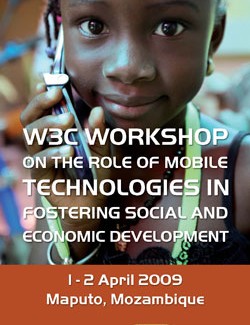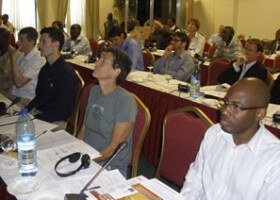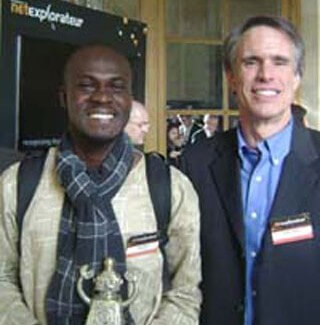I gave a talk entitled, “Breaking Barriers to Empowerment“, and encouraged the localization community to work with the Web Foundation to identify the opportunities for reducing language as a barrier to using the Web.
Archive for Web Foundation
22 September is "One Web Day"
For the vast majority of those reading this, a free and open Web is taken as a given. Today, 22 September, is One Web Day – a grass roots celebration of the value that the Web brings to the lives of those who have access to it. OWD offers a chance to reflect on the Web’s challenges and opportunities, as this medium of “humanity connected by technology” grows in size, but also, we hope, grows in accessibility, capability and value. These challenges and opportunities are the primary motivations for the Web Foundation’s mission and work.
Our friends at Mozilla.org suggest a few ways to celebrate.
Happy OWD!
Tim Berners-Lee Visiting Ghana
Tim Berners-Lee, inventor of the Web and founder of the Web Foundation, is traveling to Ghana this weekend to make new connections, and to explore opportunities for Foundation programs in the region. My WF colleague Daniel Dardailler will accompany him. Tim is looking forward to absorbing the experience and observing first hand how his invention is being used there. He will also work to understand the barriers that currently block people from using and becoming empowered by the Web.
Tim and Daniel will travel to Abiriw one day to lead a discussion with students on their experiences, challenges and hopes regarding the Web. Another visit will be to the Kofi Annan Centre of Excellence, to hear presentations from students and professors about how they think the Web can advance to better realize short and long term educational, community-focused and economic goals. I will be interested to hear how use of the Web on mobile phones is growing there (and if not, why not).
Tim and Daniel are excited for this trip and cannot wait to blog about it. Though we all travel a lot, take each trip as an opportunity to explore the situation and needs, to get inspired, and to meet the influencers who can help Web Foundation achieve our mission. Craig Heintzman’s, blog from earlier this year was an excellent case in point.
As always, we want your feedback on how the Web can support learning and development initiatives throughout the world. If you have any questions about Tim’s trip, please comment here, or email me.
A Better Web for a Better Society
We have been busy preparing for the “launch” of the Web Foundation. Though much of that work is not programmatic, I thought you might be interested in an 3-page article written by Tim Berners-Lee, Daniel Dardailler and I, summarizing the vision, challenges, opportunities and program plans for the Web and the Web Foundation:
A Better Web for a Better Society
The article was accepted as part of a key report to the July 2009 G8 Summit in Italy, and extracted onto our site with permission from the editors at the G8 Research Group at the University of Toronto (thank Madeline and John!)
In the time since this article was originally drafted, we have made significant progress in developing what we believe strongly will be unique and high-impact programs. In any case, I’d be interested in your feedback regarding whether or not the vision that is conveyed in these 3 pages resonates with you, and how it could be sharpened.
Back to launch prep …
Mozambique Workshop on Mobile Tech for Development

{http://www.digitalworldforum.eu/news/past-news/82-maputo-workshop-on-fostering-development-through-mobile-technologies From the Digital World Forum.}
Non-profits, entrepreneurs and individuals in Africa and other under-served populations are on the verge of greater connectivity and power to address their most pressing challenges by leveraging access to the World Wide Web on mobile phones. But we have work to do to get there. This is the conclusion that I left Maputo, Mozambique with, following W3C‘s Workshop on the Africa Perspective on the Role of Mobile Technologies in Fostering Social and Economic Development. The Web Foundation is proud to have been a Gold Sponsor for the event. Here are some additional, personal impressions …
- Excellent mix of expert participants. Co-chairs Stéphane Boyera (current on the Foundation and W3C staffs) and George Sadowsky gathered the most knowledgeable, experienced and nicest people. About one third are helping people in the field in domains such as agriculture, health care, government services and education. Another third are technologists with expertise in SMS, voice, the Web. The remainder come from academia, government, etc. About half of the participants are based in Africa. The other half have strong international experience. The chemistry and conversation were remarkable.
- Agenda as a Reference Library. The agenda contains links to useful papers and presentation slides. Good statistics, tech overviews, and inspirational stories from the field, illustrating successes (most importantly, in terms of serving and empowering people), as well as challenges.
- Voice and SMS on mobiles dominate now. And there are some amazing applications addressing real problems. Four examples among tens from the workshop: Eric M.K Osiakwan described the use of SMS to support election monitoring. Josh Nesbit talked about the FrontlineSMS out-of-the-box solution, and its role in fostering more efficient and effective health care Malawi as one of many applications in a growing number of locales. Ushahidi is hardening their open source platform for SMS-based crowd sourcing in times of crisis and joy, as reported by Henry Addo (I had the pleasure of meeting Henry previously in Paris in February). Brenda Burrell described how FreedomFone’s Interactive Voice Respone system is providing critical information in Africa.
- Huge, as-yet-unrealized, opportunities for people, via the Web. In the current environment, voice and text applications have advantages. But they also come with challenges and limitations in areas such as authoring, scalability, discovery, interoperability, usability, cost and global connectivity.
Fisseha Mekuria, Sean Krepp (Nokia) and Charles McCathieNevile (Opera) presented interesting stats on the rapid expansion of mobile devices and the mobile Web and a vision for continued expansion. - Path forward. People like those at the workshop, the technologies most are currently using, and the societal problems they are working to address are all important to the expanded use of the Web for development. In fact, I think that SMS and voice, as well as browsers and widgets can be effective human interfaces to the larger Web of knowledge, including locally- and globally-relevant connect. There are also barriers to the use of the Web, including availability of affordable data services, authoring tools, literacy (language and computer), content in local languages, and basic awareness of what is possible. The Web Foundation commits to address these challenges.
- We need more events like this.“When’s the next one?” was a common question toward the end of the workshop. There is strong interest in learning more about the Web, and in seeing demonstrations and receiving training on how to author mobile-friendly Web sites (see W3C’s resource center).

Photo by Steve Bratt
The co-chairs will publish a summary of the workshop on the W3C Web site, and perhaps Steph will share his personal impressions here later.
When’s the next one? Stay tuned.
20th Anniversary of the Proposal for the Web
On 13 March 2009 CERN marks the 20th anniversary of a document by Tim Berners-Lee — entitled, “Information Management : a Proposal” — describing what would become the World World Wide Web. A schedule for the celebration includes a keynote by Tim. I hope you have a chance to follow some of this via the planned Webcast.
I smile every time I am reminded of the comment that Tim’s boss, Mike Sendall, wrote on Tim’s proposal for the Web: “Vague, but exciting” ![]()
History leading up to and following Tim’s proposal is recapped on the W3C and CERN sites.
I will take a moment on this day to be thankful for Tim’s gift to the world, and for the stewardship that the World Wide Web Consortium and broader Web community have provided to ensure the creative and responsible development of what is arguably the most powerful communications medium the world has ever known. And there is still much more to do …
Diverse Web Creations From Netexplorateurs
I had the pleasure to speak at the NetExplorateur Forum in Paris earlier this month. A highlight for me was meeting a trio of the NetExplorateurs of the Year for 2009. These folks are similar in their intelligence, enterprise, energy and affability. The apps that they created to earn the award were interestingly diverse, and attest to the range of capabilities that can be made available to people using Web technologies.

Henry, from {http://www.ushahidi.com Ushahidi}, which was first used to crowdsource and map outbreaks of violence following elections in Kenya in 2008.
Ushahidi — which means ”testimony” in Swahili — was first used to crowdsource and map outbreaks of violence following elections in Kenya in 2008. Henry Addo, hailing from Ghana (and in pic to right, with me), recently joined the Ushahidi team, and was in Paris to receive well-deserved recognition for their work. I’m seeing references to Ushahidi’s systems everywhere these days, and it has been deployed to chart troubling activities in Gaza, the Congo, South Africa and elsewhere. Their maturing, open-source platform gives citizens the power to reports on events using their mobile phones, email and the Web. Geographic visualizations are created from these reports, for all to see and use.
Mobile banking is of growing importance in the developing world and elsewhere. M-banking provides the capability to accumulate savings, take out loans at reasonable interest rates, and to more fully participate in the global economy (OK … perhaps not such a wonderful privilege these days!). Brian Richardson, CEO of Wizzit, was named a NetExplorateur of the Year for bringing affordable mobile banking to people across networks and devices in South Africa, Zambia and Romania.
The last app I’ll describe is just plain fun. The product is the Sekai Camera, and Takahito Iguchi, from Tonchidot was in Paris to receive the award. With the software on your video/GPS/Web-enabled mobile phone (iPhone for now, but other platforms soon), you can capture video of the world around you, and then information just pops-up as overlays or “air tags” on the objects you are capturing. For example, you might be panning around a gallery in the Louvre, and selectable images of artwork, sounds from friends who were just there, the history of the artist, etc, start floating around the Louvre as viewed on your mobile device. You can add your own air tags too.
The growing value of the Web — whether in crisis, for commerce, or as a tool of creativity — continues to impress.
Progress and Plans
Since announcing the plan to create the World Wide Web Foundation in September 2008, this proto-Web-site has been pretty quiet. Silence should not be mistaken for inactivity. Here’s an update on what we’ve been doing, and what you will see as we ramp-up our activity during 2009.
In the last quarter of 2008, we made substantial progress on setting-up the “business” side of the Web Foundation (eg, bylaws, budgeting, boards, branding, tax-exempt applications, processes, legal services, financial services, etc). Though this work may not be interesting to most of you, it will prove important to creating a solid and flexible framework for tackling the ambitious challenges that we will undertake.
With the help of the Monitor Group, we developed the strategy for the Foundation’s future efforts. Our emphasis will be on advancing the Web to empower people and benefit humanity. We are developing plans for projects that aim to have a real impact in the world, including a blueprint for providing overall Web community focus and leadership, and for supporting Web science and standards. We also plan to launch a targeted initiative to accelerate the usability and usefulness of the Web on simple mobile phones in the hands of people who need life-critical services or who have services to provide. More on the strategy and plans in later postings.
How are we going to fund all of this work? Our 2009 began with a deposit of the first installment of the $5-million / 5-year grant from the John S and James L Knight Foundation. This generous grant is seeding the launch of the Web Foundation. As such the Knight investment is funding most operational (non-program) costs for the foreseeable future, and providing a platform upon which to raise tens of millions of dollars from foundations, corporations, and people like you and me, so that we can achieve results.
With the Knight funding in the bank and working for us, you will see an acceleration of activity on this site and elsewhere in the coming months. At the same time, I hope to see an acceleration of your participation in our activity. A completely new Web site (still at webfoundation.org) will be the focal point for building the Web Foundation community. The new site will provide a place where you — and others who care about the Web and how it can benefit humanity — will exchange ideas, identify challenges and opportunities, volunteer to work, and help to raise funds needed to fuel success.
I’m excited about the year ahead. Watch this space. And prepare to work with us here and around the globe.
Welcome to the World Wide Web Foundation
Dear Friends of the Web …
Tonight, 14 September 2008, I joined Tim Berners-Lee in Washington, DC, USA at the incredible Newseum for his announcement of the formation of the new World Wide Web Foundation. Tim’s speech is online, as well as video and photos and a press release.
Many thanks to everyone who has helped get us to this first step:
- Alberto Ibargüen and the Knight Foundation for their very generous seed grant.
- The World Wide Web Consortium (W3C) and Web Science Research Initiative, and the joint task force behind this project: Tim, Stéphane Boyera, Daniel Dardailler, Craig Heintzman, Rosemary Leith, Mauro Nunez and Thomas Roessler.
- Ian Jacobs, Karl Dubost, Ted Guild and many others from the W3C systems and communications teams for building this Web site.
The promise of the Foundation is to accelerate the Web’s advancement and growth around the planet. It is pretty exciting to be a part of it. We are still in the planning phase, and I expect to use this blog to share more information as we progress towards a full launch in early 2009. All those interested in becoming founding donors for this initiative are welcome to contact me at donations at webfoundation dot org.
Beyond financial contributions, what about contributions of intellectual capital? It would be great to hear your ideas on how the community that is developing the Web used now by about 1/5th of the inhabitants of the planet could contribute their time and skills to bring the benefits of the Web to the other 4/5ths.
Have a look around the new site. If you have any questions or ideas, send me email at contact at webfoundation dot org.
